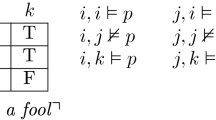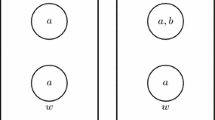Abstract
Epistemic two-dimensional semantics is a theory in the philosophy of language that provides an account of meaning which is sensitive to the distinction between necessity and apriority. While this theory is usually presented in an informal manner, I take some steps in formalizing it in this paper. To do so, I define a semantics for a propositional modal logic with operators for the modalities of necessity, actuality, and apriority that captures the relevant ideas of epistemic two-dimensional semantics. I also describe some properties of the logic that are interesting from a philosophical perspective, and apply it to the so-called nesting problem.
Similar content being viewed by others
References
Chalmers, D. J. (1996). The conscious mind. Oxford: Oxford University Press.
Chalmers, D. J. (2004). Epistemic two-dimensional semantics. Philosophical Studies, 118, 153–226.
Chalmers, D. J. (2006a). Two-dimensional semantics. In B. C. Smith & E. Lepore (Eds.), The Oxford handbook of philosophy of language (pp. 574–606). Oxford: Oxford University Press.
Chalmers, D. J. (2006b). The foundations of two-dimensional semantics. In M. García-Carpintero & J. Macià (Eds.), Two-dimensional semantics (pp. 55–140). Oxford: Oxford University Press.
Chalmers, D. J. (2011a). Actuality and knowability. Analysis, 71, 411–419.
Chalmers, D. J. (2011b). Propositions and attitude ascriptions: A Fregean account. Noûs, 45, 595–639.
Chalmers, D. J. & Rabern, B. Two-dimensional semantics and the nesting problem. Unpublished.
Crossley, J. N., & Humberstone, L. (1977). The logic of “actually”. Reports on Mathematical Logic, 8, 11–29.
Davies, M., & Humberstone, L. (1980). Two notions of necessity. Philosophical Studies, 38, 1–30.
Dever, J. (2007). Low-grade two-dimensionalism. Philosophical Books, 48, 1–16.
Edgington, D. (2004). Two kinds of possibility. Aristotelian Society Supplementary Volume, 78, 1–22.
Forbes, G. (2011). The problem of factives for sense theories. Analysis, 71, 654–662.
Fritz, P. What is the correct logic of necessity, actuality and apriority? Unpublished.
Glüer, K., & Pagin, P. (2006). Proper names and relational modality. Linguistics and Philosophy, 29, 507–535.
Glüer, K., & Pagin, P. (2012). Reply to Forbes. Analysis, 72, 298–303.
Halbach, V. (2009). On the benefits of a reduction of modal predicates to modal operators. In A. Hieke & H. Leitgeb (Eds.), Reduction–abstraction–analysis (pp. 323–333). Heusenstamm: Ontos Verlag.
Hanson, W. H. (2006). Actuality, necessity, and logical truth. Philosophical Studies, 130, 437–459.
Humberstone, L. (2000). Review of ‘Multi-dimensional modal logic’ by Maarten Marx and Yde Venema. Studia Logica, 65, 278–282.
Humberstone, L. (2004). Two-dimensional adventures. Philosophical Studies, 118, 17–65.
Kamp, H. (1971). Formal properties of ‘now’. Theoria, 37, 227–273.
Kaplan, D. (1989). Demonstratives. In J. Almog, J. Perry, & H. Wettstein (Eds.), Themes from Kaplan (pp. 481–563). Oxford: Oxford University Press.
Kripke, S. A. (1980 [1972]). Naming and necessity. Cambridge, MA: Harvard University Press (First published in D. Davidson & G. Harman (Eds.), Semantics of natural language (pp. 253–355, 763–769). Dordrecht: D. Reidel).
Michels, R. (2012). Soames’s argument 1 against strong two-dimensionalism. Philosophical Studies, 161, 403–420.
Montague, R. (1963). Syntactical treatments of modality, with corollaries on reflexion principles and finite axiomatizability. In Proceedings of a colloquium on modal and many-valued logics, volume 16 of Acta Philosophica Fennica (pp. 153–167). Helsinki: Societas Philosophica Fennica.
Montague, R. (1970). Universal grammar. Theoria, 36, 373–398.
Restall, G. (2012). A cut-free sequent system for two-dimensional modal logic, and why it matters. Annals of Pure and Applied Logic, 163, 1611–1623.
Schroeter, L. (2010). Two-dimensional semantics. In E. N. Zalta (Ed.), Stanford encyclopedia of philosophy. Winter 2010 edition.
Schwarz, W. Variations on a Montagovian theme. doi:10.1007/s11229-012-0173-0. Forthcoming.
Segerberg, K. (1971). An essay in classical modal logic. Number 13 in Filosofiska Studier. Uppsala: Uppsala Universitet.
Segerberg, K. (1973). Two-dimensional modal logic. Journal of Philosophical Logic, 2, 77–96.
Soames, Scott. (2005). Reference and description: The case against two-dimensionalism. Princeton: Princeton University Press.
Stalnaker, R. C. (1978). Assertion. In P. Cole (Ed.), Syntax and semantics: Pragmatics (Vol. 9, pp. 315–332). New York: Academic Press.
van Benthem, J. (1987). Meaning: Interpretation and inference. Synthese, 73, 451–470.
Williamson, T. (1986). The contingent a priori: Has it anything to do with indexicals? Analysis, 46, 113–117.
Williamson, T. How deep is the distinction between a priori and a posteriori knowledge? In A. Casullo & J. C. Thurow (Eds.), The A Priori in Philosophy. Oxford: Oxford University Press. Forthcoming a.
Williamson, T. Modal logic as metaphysics. Oxford: Oxford University Press. Forthcoming b.
Acknowledgments
This paper is based on my master’s thesis, written in 2011 at the ILLC, University of Amsterdam, and supervised by Paul Dekker and Yde Venema. I thank them, as well as David Chalmers, Jeremy Goodman, Emar Maier, Peter Pagin, Brian Rabern, Robert van Rooij, Wolfgang Schwarz, and Timothy Williamson for discussions on various stages and predecessors of this paper. I also thank audiences in Cologne, Amsterdam, Stockholm and London as well as two anonymous reviewers for comments. I especially thank Robert Michels for many helpful discussions and detailed written comments on several drafts of this paper. This article was written while I was supported by a doctoral studentship from the Arts and Humanities Research Council.
Author information
Authors and Affiliations
Corresponding author
Rights and permissions
About this article
Cite this article
Fritz, P. A logic for epistemic two-dimensional semantics. Synthese 190, 1753–1770 (2013). https://doi.org/10.1007/s11229-013-0260-x
Received:
Accepted:
Published:
Issue Date:
DOI: https://doi.org/10.1007/s11229-013-0260-x




